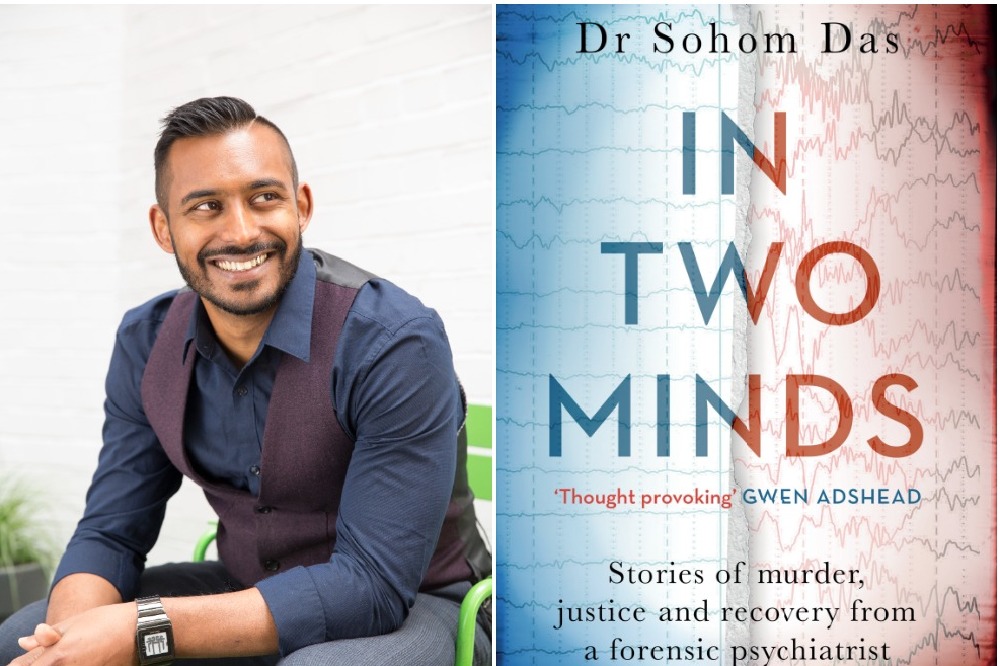Psychiatrists assess, diagnose and treat mental illnesses. Just like surgeons specialising in different parts of the body, there are numerous types of sub- specialist psychiatrists. More than you can stroke a beard at, each with expertise in treating particular categories of mental illness. General adult psychiatrists are the most common breed. There are also old- age psychiatrists and addiction specialists. Forensic psychiatrists are a different species from other psychiatrists; we assess, treat and rehabilitate offenders, usually perpetrators of violent and sexual crimes. We also sometimes also act as expert witnesses to advise judges and juries in criminal trials about individual defendants who have, or are suspected of having, psychiatric issues.

Dr Sohom Das, In Two Minds
Contrary to popular belief, including my own, I quickly learnt that forensic psychiatrists have no business whatsoever at crime scenes. Jaded TV homicide detectives might take a swig of their coffee and ask a minion for ‘forensics’ on bullets, and the very charming Dick Van Dyke might visit the local morgue and ask for ‘forensics’ on a dead body, but they are asking for ballistics and pathological examinations, respectively. The term ‘forensics’ is often associated with solving crimes. The word comes from the Latin word ‘forēnsis’, meaning ‘before the forum’; in Roman times, criminal charges would be discussed before a group of public individuals, in a kind of precursor of the modern- day criminal trial. The term encompasses offending, the legal system and courts in general. In psychiatry, it’s about the juxtaposition of mental illness and criminality. The context is often one of ascertaining the mental state of an offender during a crime, by examining the evidence afterwards. It’s about deciphering an individual’s risk factors for future violence, and reducing them through intense long- term rehabilitation and treatment. So, pretty much everything except for solving crimes.
We cannot figure out if Colonel Mustard killed Professor Plum in the kitchen with the candlestick or not. But after he is charged, we can figure out which personality traits and psychotic symptoms drove Colonel Mustard to act so violently and impulsively, ascertain whether he was criminally culpable, and rehabilitate him so he is safe to rejoin society.
Criminal profiling is also not on the agenda for a forensic psychiatrist. This is the practice of identifying likely suspects to assist the police or of linking cases that may have been committed by the same perpetrator. It also involves predicting the future actions of a criminal at large (occasionally, according to the programmes I’ve seen, through telepathy).
‘Judging by the way he’s taunting the detectives, this man is a narcissist and probably works in advertising.’
‘His crimes are escalating and he’s becoming more emboldened. I think his next attack will be in broad daylight, superintendent.’
. . .are a couple of sentences I have never uttered.
In my opinion, criminal profiling is at best a pseudoscience and at worst a scam, even though people (not qualified forensic psychiatrists) have made careers out of it. There is a lack of scientific research or evidence to support its usefulness, reliability and validity. It works on the assumption that criminals operate in a predictable manner. And also that there is consistency within their modus operandi and their motivation, both within one particular perpetrator and between them. Having read hundreds of case papers outlining details of offences, including some by the same individual, and having discussed culprits’ thought processes with them, I can confidently say that these patterns do sometimes occur. But equally, they don’t. There is chaos, randomness and opportunism in many serious crimes. There is not enough consistency or even enough data to predict the profile of an offender, in my humble opinion.
One of the most high-profile cases where this dark art has hindered a police investigation was the murder of Rachel Nickell. In July 1992, Ms Nickell, a twenty-three-year-old former model, was sexually assaulted and stabbed forty-nine times while walking her dog with her two-year-old son on Wimbledon Common in the early hours of the morning. The prime suspect was a man named Colin Stagg, but the authorities had little evidence linking him to the murder scene. The police therefore asked a renowned criminal psychologist to create an offender profile of the killer, which fitted Stagg.
They then set up an entrapment-style sting, with the psychologist’s assistance, where an attractive undercover policewoman befriended and flirted with Stagg to coax out and secretly record violent fantasies and, they hoped, a confession from him. Although he played along to a degree, Stagg did not admit to Ms Nickell’s murder, but was prosecuted anyway. The mind doth boggle. At trial, the case was thrown out by the judge at the Old Bailey, who declared that the police had tried to incriminate the suspect by ‘deceptive conduct of the grossest kind’. The police and criminal psychologist were criticised (the latter was charged with professional misconduct by the British Psychological Society, though the case was later dropped). In July 2006, after re- examining some evidence, the police interviewed a convicted murderer named Robert Napper, who had paranoid schizophrenia and Asperger’s syndrome, at Broadmoor Hospital, where he had been a patient for a decade. He had already been convicted of a very similar murder of another young woman named Samantha Bisset and her four- year- old daughter in November 1993. At trial, he pleaded guilty to the manslaughter of Ms Nickell on the grounds of diminished responsibility. The judge ordered that Napper would be held at Broadmoor Hospital, indefinitely.
What is particularly upsetting for me about this whole debacle is that Samantha Bisset and her four-year-old daughter’s deaths may have been prevented had this rogue criminal profiler-led sting operation not distracted the authorities.
Interviewing suspects is another area I had wrongly assumed we might be involved in when I first paddled into the ocean of forensic psychiatry. The idea of sitting across the table from a suspected murderer, with police officers observing incredulously behind a one- way mirror as I play intellectual chess to coax the slippery mastermind into incriminating himself does sound enticing. I’m sure experienced detectives have sharpened their skills and perfected their mind games to do this very thing. Any questionable abilities I may claim to have in this area are strictly from watching Netflix crime dramas. If you put a biro in front of the accused and they don’t play with it, they are too calm, calculated and unemotional. They are definitely, 100 per cent guilty. Or was that not guilty? These techniques are categorically never utilised in my profession.
Having said that, I do look at the consistency and reliability of the interviewee during my own assessments. Defendants fabricating mental illness is certainly not unusual. But this is all in the context of eliciting symptoms in order to refute or validate a diagnosis, not for confessions of murder.
To this day, I am frequently asked about delving into the minds of serial killers or terrorists and explaining their behaviour. This included being a guest on a podcast about Ted Bundy, the American serial killer and rapist who is believed to have murdered at least twenty-eight women in the 1970s. I suggested that he had the superficial charm, callous disregard for the rights of others and the glib, manipulative nature of a psychopath. The host, clearly unsatisfied, pushed me repeatedly to explain why Bundy carried out his dozens of rapes and homicides, almost as if I was in the dock. As I told her, I’m not sure there’s an answer that makes sense to anybody other than Ted Bundy. In my career, I have assessed a handful of perpetrators of multiple murders and acts of terror. The vast majority have been initial assessments to rule out acute severe mental illness, allowing the defendant to be dealt with by the usual criminal justice route. If they have no discernible mental illness, there is no room for curing, and therefore no role for my services or expertise. These horrific acts are thankfully uncommon. But for them to be directly driven by psychiatric symptoms, as opposed to simple hatred, is as rare as chicken’s fangs. I have been asked on several occasions, including once on live radio, about what drives serial killers and terrorists. The truth is that the answers lie outside of psychiatry, and more in the field of criminology.
Some might proffer that the very acts of serial killers and terrorists prove that they must be mentally ill. This boils down to how you define mental illness. If you consider having murderous thoughts or ideas of extreme fundamentalist hatred, as well as having the conviction to carry these out, as automatically being mentally ill, then yes, clearly these people are that. However, for psychiatrists, hatred, anger, fascism and even religious fanaticism are not in themselves psychiatric symptoms. It is only in exceptional cases that they are the product of, or the outward expression of, underlying mental illness. Only those in this minuscule category could potentially be treated by us.
Dr Sohom Das is a Forensic Psychiatrist, author of new book In Two Minds: Stories of Murder, Justice and Recovery from a Forensic Psychiatrist, and host of YouTube channel A Psych for Sore Minds.


